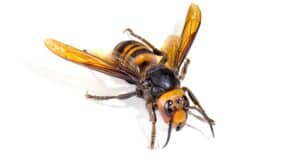Texas is America’s fourth hottest state. And where there’s heat, there are insects. Wasps are no exception. If you’ve ever been stung by a wasp, the first whir of a buzz may send you running inside, especially if that wasp is a glaring bright red.
The predatory red wasp is considered a nuisance to Texas residents, and there is no denying that these insects conjure panic. But are these rusty red arthropods dangerous or just slightly bothersome? Learn how to spot red wasps in Texas, including where you can find them and if they pose a threat to humans.
How to Identify Red Wasps in Texas
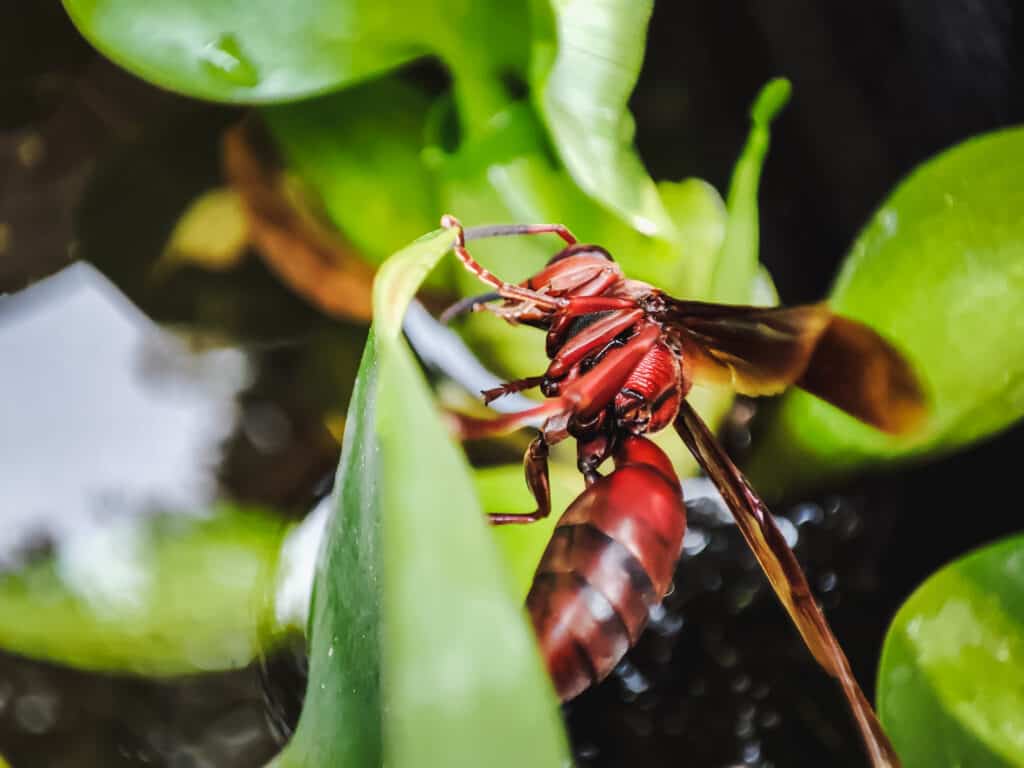
Red wasps have slender waists and rusty-red coloring with black wings.
©iStock.com/Riki I Gunawan
The red paper wasp inhabits the eastern part of the United States from Texas to Florida, as far north as New York and west as Nebraska. These paper wasps are around an inch long with slender, narrow waists. Their bodies are a rusty red coloring all over, except for their wings, which are a smoky black.
There are two species of red wasps in Texas: Polistes rubiginosus and Polistes carolina. Rubiginosus has coarser ridges on its first abdominal section. Both are social wasps in the Vespidae family and prefer to build their nests in protected areas. Paper wasps differ from yellowjackets and hornets and build their nests with open cells, not covered with a cap.
Red wasps build their nests from wood fiber that they collect from plant stems and posts. They chew the fiber and then shape the paper-like material into hexagonal cells; some nests contain up to 200 cells. The primary purpose of a wasp nest is to protect the queen, her eggs, and larvae. Colony members also rest on the nest at night.
During the day, red wasps feed on the sweet nectar produced by flowers. They also forage and prey on insects like caterpillars, flies, and beetle larvae, which they provide to their larvae.
Where Can You Find Them?
You will find the red wasp most commonly in East Texas. This species prefers to hang its nest in protected areas like hollow trees in woodland environments, but given the opportunity, it will also build its home near humans.
Because red wasps make their nests from wood fiber, they tend to settle in areas with plenty of resources. Check for these honeycomb nests under porch ceilings, roofs, inside walls, and attics. Also, check behind shutters and nearby trees on your property.
Are Red Wasps Dangerous?
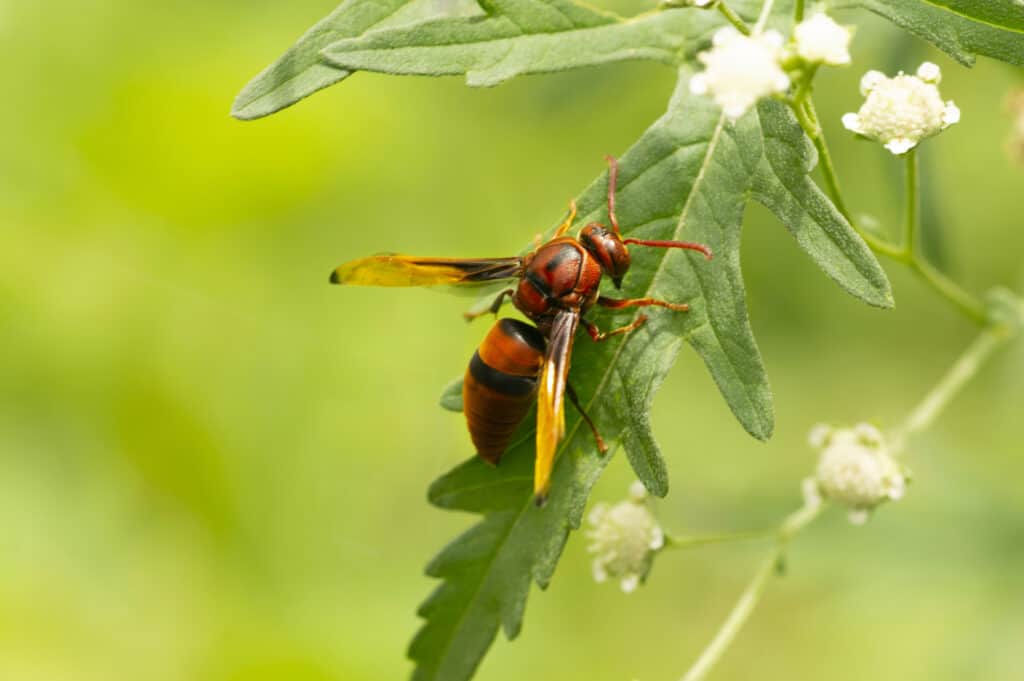
Red wasps are more docile than other wasps.
©iStock.com/ePhotocorp
Red wasps may look menacing, but they are pretty docile compared to other wasp species. However, they may feel threatening due to the likelihood of them building nests near your home. Red wasps typically won’t attack or sting humans unless provoked. They are protective of their nests and may try to chase people and pets away if they get too close.
Unlike bees, their stingers don’t come off. When they do sting, they sting multiple times. If you don’t leave the area immediately, you may get stung more than once. Wasps stings are painful but start to fade within 24 hours. Most people who get stung don’t develop severe complications and can treat the affected area with cold packs and mild pain medicine. Some people develop life-threatening allergic reactions to wasp stings and may need immediate medical care. Seek emergency care if you are allergic or think you may have developed an infection.
How to Get Rid of Red Wasps
We value and respect the lives of all animals on the planet. But when certain creatures try to co-habit with us, sometimes it’s not good. As much as you may want to respect the red wasp nest nestled in a corner just above the front door of your home, you also don’t want to be stung trying to enter or exit your house! So how can you get rid of red wasps safely and effectively?
One tactic–and perhaps the most humane–is to remove their nests. It’s important to remove a nest as soon as possible before the wasps grow very big. Some ways to remove the nest can include spraying it with a water hose or knocking it down with a garden tool. You’ll need to make sure that you are far enough away from the next not to invite an attack. It’s also important to think about how you can escape in case wasps do happen to swarm at you–is there a clear path to exit the area?
There are plenty of products in hardware stores to deal with red wasps, whether they be sprays that kill them (some are designed to shoot long distances), or traps. These can not only be effective when going after nests, but may be necessary if you get red wasps in your house.
Red wasps are inactive at night and retreat to their nests. So if there’s any yard work that you can get done at night, that’s another idea to avoid provoking them.
Other Wasps in Texas
There are 125 wasp species in Texas. Take a look at some of the most common.
Bald-Faced Hornet
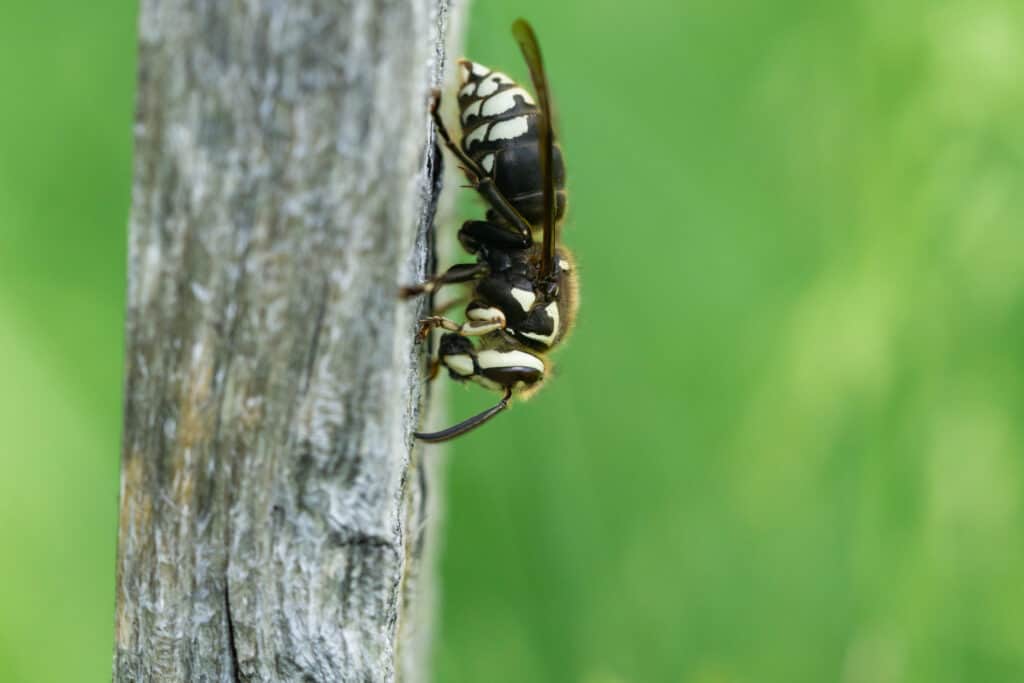
The bald-faced hornet is a yellowjacket species and is not a true hornet.
©iStock.com/ErikAgar
The bald-faced hornet is a yellowjacket species and is not a true hornet. It gets its name from its intimidating size and aggressive behavior. Its body is predominately black with a white-patterned face. This wasp likes to build its nest in residential areas on tree branches, and its sting is similar to a red wasp’s.
Tarantula Hawk Wasps

Tarantula hawks inflict one of the most painful bites in the world. They live in desert habitats in Texas.
©iStock.com/Rainbohm
Tarantula hawk wasps live in desert habitats in Texas and are just as horrifying as they sound. They are around two inches long, with black and blue bodies and rust-colored wings. They are among the largest among the wasp family, and their sting is one of the most painful insect stings in the world. As their name suggests, they feed on tarantulas by paralyzing them and then dragging them to their nest. They then lay an egg on the spider, which hatches into larvae and eats the still-living prey.
Cicada Killer
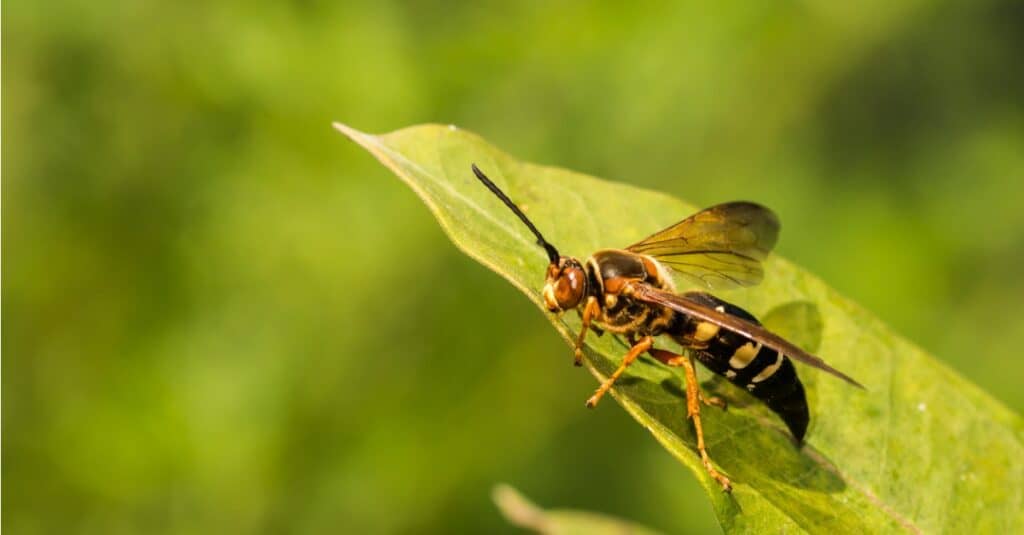
Cicada killers are the gentle giants of the wasp world and can be found throughout Texas.
©iStock.com/JasonOndreicka
Cicada killers, or sand hornets, are digger wasps that inhabit areas east of the Rocky Mountains. They prey on cicadas, controlling their population and benefiting deciduous trees. Texas has two species of cicada killers, with the eastern killer being more common throughout the state. Despite their scary-sounding name, cicada killers are considered the “gentle giants” of the wasp world. Males don’t sting; females only deploy their stingers in extreme cases. Cicada killers are black, with yellow stripes and brown wings, and they prefer sandy soil for their ground nests.
Are Wasps in Texas beneficial to the environment?
The sight of a wasp nest around your home can be frightening, especially if you have pets and young children. And no one would judge you for calling a pest control specialist to have it removed. But if you have a nest further away from your dwelling that doesn’t interfere with your livelihood, it may be a good idea to leave it alone. The reason? Wasps, like bees, are good for the environment.
Wasps are pollinators and essential for the survival of a range of flowers, trees, and vegetables. This species, like most wasps, control top crop predators. They consume some of the most severe agricultural pests like caterpillars and beetles. This natural pest controller is essential in farming, agriculture, and horticulture.
How Do You Treat a Red Wasp Sting in Texas?
Following the initial sting, wasp stings typically result in minor discomfort, often manageable with home remedies. Common symptoms of a wasp sting include localized pain, swelling, redness that may extend beyond the sting site, itching, warmth at the sting site, and in some cases, the development of hives if your body reacts to the sting.
In the event of a bee or wasp sting, take these steps:
- Remove the stinger
- Cleanse the affected area with soap and water
- Cover it
- Maintain cleanliness
To reduce swelling, apply a cold pack for 15-20 minutes. If necessary, seek medical assistance.
You can alleviate pain with aspirin or another pain reliever and soothe itching with a cortisone cream.
The photo featured at the top of this post is © iStock.com/ePhotocorp
Thank you for reading! Have some feedback for us? Contact the AZ Animals editorial team.





